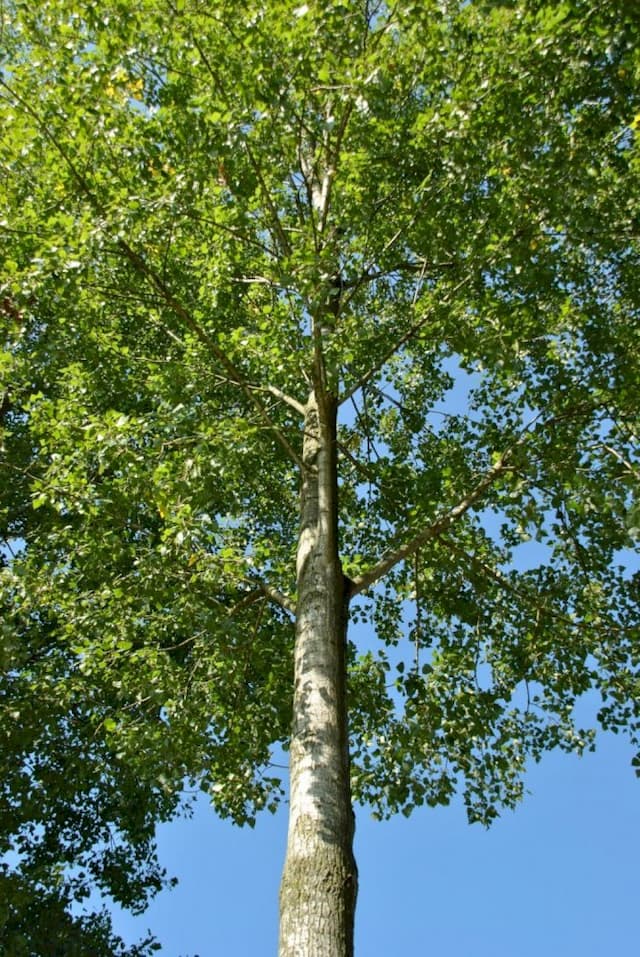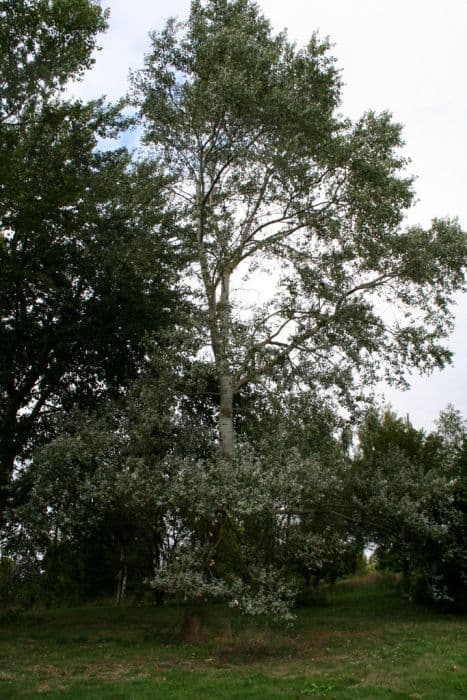Basket Willow Salix viminalis

ABOUT
Salix viminalis, commonly known as the basket willow or osier, is a species known for its slender and flexible twigs. The plant has a graceful appearance, with long, narrow green leaves that are slightly twisted. The leaves are glossy on top with a paler, hairy underside, giving them a silvery shimmer when they dance in the breeze. During the spring, the basket willow produces yellow catkins, which provide an attractive display of color. These catkins are followed by small, capsule-like fruits that release tiny seeds. The bark on mature plants is dark and furrowed, while on younger stems, it is smooth and reddish-brown. The twigs often have a golden hue which makes them highly desirable for basket weaving and other ornamental uses. Overall, the basket willow has a sturdy yet elegant form that is distinguished by its vibrant twigs and foliage.
About this plant
 Names
NamesFamily
Salicaceae
Synonyms
Basket Willow, Osier, Common Osier, Viminal Willow
Common names
Salix viminalis var. calcicola, Salix viminalis var. gigantea, Salix viminalis var. viminales.
 Toxicity
ToxicityTo humans
Salix viminalis, commonly known as basket willow, is not considered highly toxic to humans. However, like other willow species, it contains salicin, which is a precursor to aspirin. Ingesting small quantities of the plant (specifically the bark) is generally not harmful and has even been used historically for its medicinal properties. However, in large quantities, salicin can be toxic and may lead to symptoms similar to those of aspirin overdose, which include nausea, vomiting, diarrhea, headache, dizziness, tinnitus (ringing in the ears), and in severe cases, respiratory alkalosis or metabolic acidosis. It is always advisable to consult a healthcare professional if you suspect poisoning from any part of the plant.
To pets
Salix viminalis, commonly known as basket willow, is generally considered to have low toxicity for pets. However, the salicin present in the willow bark can be toxic in large amounts. While small ingestions are unlikely to cause more than mild stomach upset, large amounts could result in symptoms similar to those experienced by humans, including vomiting, diarrhea, or more serious effects like salicylate toxicity, which translates to symptoms such as loss of appetite, lethargy, abdominal pain, and potential damage to the digestive tract. If a pet shows signs of distress after ingesting part of the basket willow, it is important to seek veterinary care promptly.
 Characteristics
CharacteristicsLife cycle
Perennials
Foliage type
Deciduous
Color of leaves
Green
Flower color
Yellow
Height
10-15 feet (3-4.5 meters)
Spread
10-15 feet (3-4.5 meters)
Plant type
Tree
Hardiness zones
2-9
Native area
Europe
Benefits
 General Benefits
General Benefits- Renewable Energy Source: Salix viminalis, commonly known as basket willow, is used for biomass production due to its rapid growth and high calorific value.
- Erosion Control: The dense root system of the basket willow stabilizes soil and can help to prevent soil erosion along riverbanks and wetland areas.
- Wildlife Habitat: Basket willow provides food and shelter for a wide variety of wildlife, including birds, insects, and small mammals.
- Biomaterials: The flexible stems of basket willow are traditionally used in basketry, weaving, and crafting wicker products.
- Phytoremediation: Salix viminalis absorbs heavy metals and other contaminants from soil and water, making it useful for cleaning up polluted sites.
- Windbreak: When grown in rows, the plants can act as windbreaks, offering protection to crops and reducing soil desiccitation.
- Landscape Aesthetics: With its long, slender branches and narrow leaves, the basket willow is also planted for ornamental purposes, enhancing the aesthetics of landscapes.
- Support for Beneficial Insects: Basket willow flowers provide pollen and nectar for bees and other pollinating insects, important for ecosystem health and agriculture.
 Medical Properties
Medical Properties- Analgesic: Salix viminalis contains salicin, which may be converted to salicylic acid in the body, providing pain relief.
- Anti-inflammatory: The salicylic acid derived from salicin in Salix viminalis may help reduce inflammation.
- Antipyretic: Salicin is believed to have fever-reducing properties, which could make Salix viminalis a natural antipyretic agent.
- Rheumatic relief: Traditionally, extracts from this willow species have been used to ease rheumatic pain.
 Air-purifying Qualities
Air-purifying QualitiesThis plant is not specifically known for air purifying qualities.
 Other Uses
Other Uses- Art and Craft Material: The flexible branches of Salix viminalis, also known as osier, are often used in basket weaving and for creating sculptures.
- Fodder for Livestock: The leaves and young shoots of osier are sometimes used to feed livestock, particularly goats.
- Erosion Control: Osier's robust root system can help stabilize soil and prevent erosion on riverbanks and other susceptible areas.
- Barriers and Fencing: The strong, interwoven branches of osier can be fashioned into living fences or barriers for windbreaks or privacy screens.
- Water Filtration: Osier is sometimes planted in constructed wetlands to help filter and clean polluted water.
- Phytoremediation: Osier has the capacity to absorb heavy metals from the soil, making it useful for cleaning contaminated land.
- Landscaping: Due to its fast growth and attractive appearance, osier is used in landscaping for ornamental purposes.
- Support for Climbing Plants: Osier branches can serve as natural stakes or trellises in the garden for supporting climbing plants like peas and beans.
- Wildlife Habitat: Osier plantations provide a habitat for a diversity of wildlife, particularly birds and insects.
- Crafting Musical Instruments: The wood from osier can be used to make parts of some musical instruments, such as drum sticks or other percussive tools.
Interesting Facts
 Feng Shui
Feng ShuiThe Basket Willow is not used in Feng Shui practice.
 Zodiac Sign Compitability
Zodiac Sign CompitabilityThe Basket Willow is not used in astrology practice.
 Plant Symbolism
Plant Symbolism- Flexibility: Salix viminalis, commonly known as osier, has very supple and flexible stems. This characteristic lends itself to the symbolic meaning of adaptability and resilience, emphasizing the ability to bend without breaking in the face of adversity.
- Growth and Renewal: As a fast-growing plant, osiers are often associated with new beginnings and the swift passage from one phase of life to another, symbolizing the continuous cycle of growth and renewal.
- Healing: Historically, the bark of osier has been utilized for its medicinal properties. This aspect conveys a symbolic significance of healing, both physical and emotional restoration.
- Connections and Bonds: Due to their use in basket weaving and the creation of ties and bonds, osiers represent connections between people, the strength in relationships, and the interwoven nature of community.
 Water
WaterThe Basket Willow should be watered regularly with deep watering to encourage a strong root system. During the growing season, water the plant once a week with one to two gallons, depending on rainfall and soil moisture levels. In hot, dry periods, increase the frequency to twice per week, ensuring the soil remains moist but not waterlogged. During dormancy in winter, reduce watering to prevent root rot, especially if the soil is naturally wet. It’s important to never let the soil dry out completely.
 Light
LightBasket Willow requires full sun for optimal growth, meaning at least six hours of direct sunlight each day. The best spot for this plant would be an open area away from large trees or structures that could cast shade. The plant can tolerate partial shade, but its growth may be less vigorous.
 Temperature
TemperatureThe Basket Willow thrives in a temperature range between 35 to 75 degrees Fahrenheit. It can survive minimum temperatures to around -20 degrees Fahrenheit, but growth will be best when temperatures are within the ideal range. The willow is quite hardy and adaptable to various climate conditions but should be protected from extreme heat.
 Pruning
PruningPrune the Basket Willow in late winter or early spring before new growth begins to remove any dead or damaged branches and to shape the plant. This encourages new growth and maintains plant health. Prunings can be done annually, and more often if you are growing the willow for its rods, which are harvested every one to two years.
 Cleaning
CleaningAs needed
 Soil
SoilBasket Willow thrives best in moist, well-drained loamy soils with a neutral to slightly acidic pH ranging from 6.0 to 7.0. A mix of two-thirds loam and one-third aged compost or manure will support robust growth. Regular additions of organic matter can help maintain soil fertility and structure.
 Repotting
RepottingBasket Willows, being large shrubs or small trees, are not typically repotted as they are usually planted directly in the ground. If grown in containers, young willows may need repotting every 2 to 3 years into larger pots until they reach maturity or are planted out.
 Humidity & Misting
Humidity & MistingThe Basket Willow prefers outdoor conditions with natural ambient humidity. It is adaptable to a wide range of humidity levels and does not require specific humidity adjustments when planted in its ideal outdoor environment.
 Suitable locations
Suitable locationsIndoor
Grow Basket Willow indoor with bright light, large space.
Outdoor
Plant Basket Willow in sunny spot, moist soil, room for growth.
Hardiness zone
4-9 USDA
 Life cycle
Life cycleSalix viminalis, commonly known as basket willow, begins its life as a seed, which sprouts in moist soil in early spring. The seedling rapidly grows into a young plant, utilizing the long daylight hours of spring and summer to photosynthesize and build a sturdy root system. As it matures, the basket willow develops a distinctive narrow and upright growth habit, with long, slender leaves and catkins that appear in early spring before the leaves; these catkins are important for pollination, as they house the reproductive organs. Once pollinated, the catkins develop into small capsules that release tiny, cotton-tufted seeds dispersed by wind and water. The willow tree can also propagate vegetatively through cuttings, which root readily to form new plants. After a number of years, which can vary from 5 to 20 or more, the basket willow reaches its mature stage, capable of producing seeds or cuttings of its own, thus continuing the cycle.
 Propogation
PropogationPropogation time
Early spring
Propogation: The most common method of propagating Salix viminalis, commonly known as the basket willow, is by cuttings. This process is often done during the dormant season, typically from late winter to early spring. For this method, healthy shoots from the previous year's growth are selected and cut into lengths of about 9 to 12 inches (approximately 23-30 cm). These cuttings should then be planted directly into moist soil with about two-thirds of their length buried. This encourages the development of a strong root system. Willow cuttings root easily, and no rooting hormones are usually required. By the following growing season, these cuttings will have often taken root and begun to grow into new plants.









